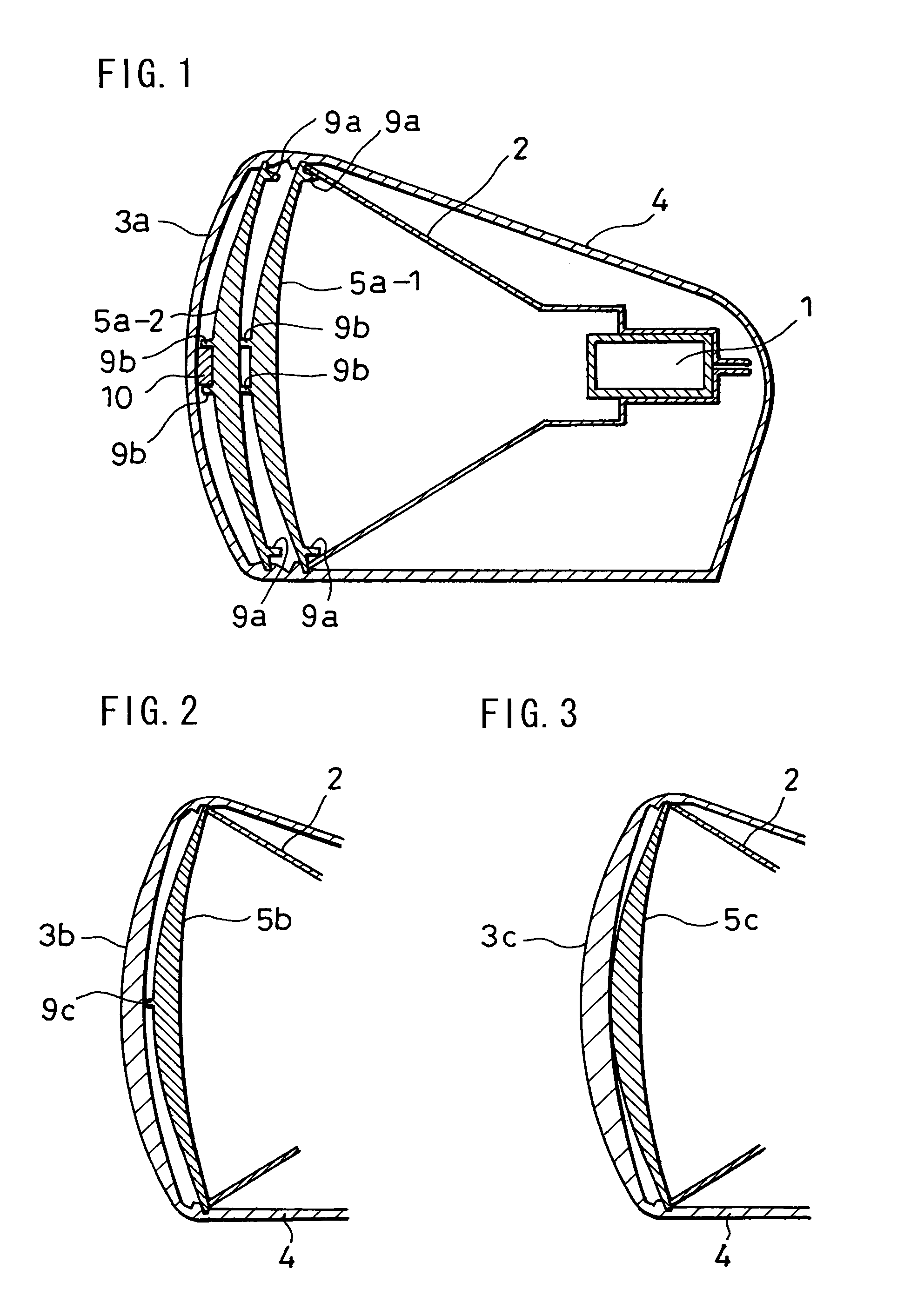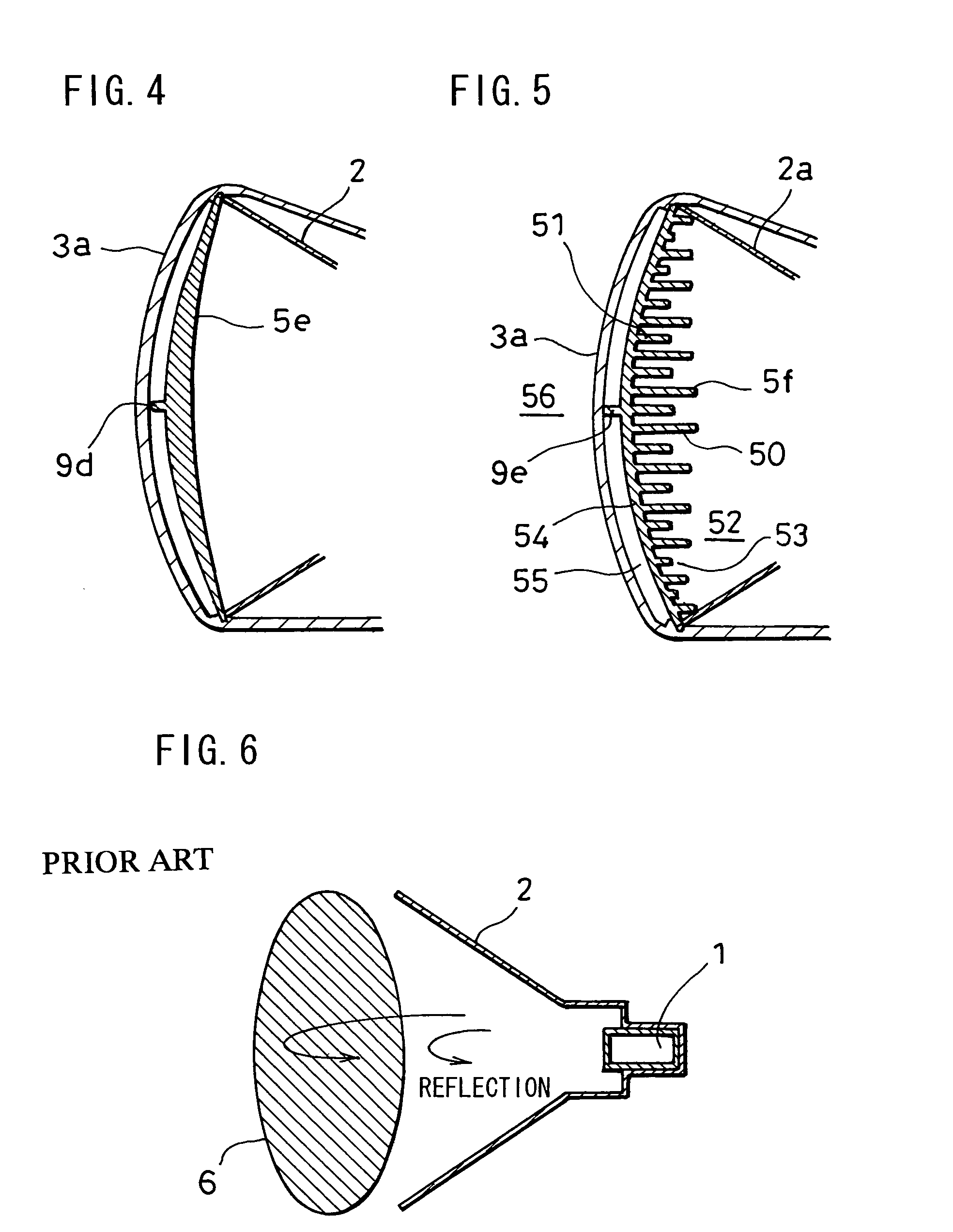Fan-beam antenna
a technology of fan beam and antenna, which is applied in the direction of antennas, subaqueous/subterranean adaption, radiating element housings, etc., can solve the problems of difficult method of manufacturing compound materials, large thickness of lens, and large size in propagation direction, so as to achieve the necessary lens effect and restrain bad reflection
- Summary
- Abstract
- Description
- Claims
- Application Information
AI Technical Summary
Benefits of technology
Problems solved by technology
Method used
Image
Examples
first embodiment
[0031]A cross section view illustrating a fan-beam antenna according to the present invention is shown in FIG. 1.
[0032]A fan beam antenna shown in FIG. 1 is an example in which a slot waveguide (1) is employed as an array element, wherein two convex-lens-shaped dielectric lenses (5a-1, 5a-2) and radiation surface radome (3a) formed by a dielectric with an even thickness are arranged in an opening portion of a flare (2) and the other portions are covered with a water-proof box (4). Note that mechanical support means for the slot waveguide and the flare, and a feeder system etc. are omitted in the drawing.
[0033]Besides, in this embodiment, the radiation surface radome (3a) and the water-proof box (4) are united and formed by a cylindrical extrusion molding. Furthermore, the dielectric lenses (5a-1, 5a-2) are approximately the same shape and formed by an extrusion molding or an injection molding, having a structure to be fit into the water-proof box (4).
[0034]Moreover, in this embodime...
second embodiment
[0056]FIGS. 2, 3 and 4 illustrate cross sectional views of a fan-beam antenna according to the present invention.
[0057]FIG. 2 shows an example in which a radome itself is a convex-shaped dielectric lens (3b) and a dielectric lens (5b) which is similar to the dielectric lens (3b) is located inside thereof, a thickness of a center of each lens is set to an electric length equal to or less than a quarter wavelength of a used frequency, and pitch between two lenses over a whole of the vertical surface is set to a quarter wavelength of the electric length.
[0058]With this arrangement, an excellent effect for restraining reflection can be gained in a principle such that two same waves which are separated at intervals of a quarter wave length in an advanced direction thereof are negated. Note that the dielectric lens (5b) in FIG. 2 is provided with a spacer projection (9c) at a center thereof.
[0059]FIG. 3 shows an example in which a radome itself is a convex-shaped dielectric lens (3c) and ...
third embodiment
[0064]FIG. 5 illustrates a cross sectional view of a fan-beam antenna according to the present invention. In the embodiment in FIG. 5, a point such that a dielectric lens (5f) is formed so as to have a comb-shaped cross section is different from the above embodiments. In this case, this embodiment is such that reflection is restrained by a structure as follows such as to apply an average dielectric constant by gaps (53) between comb tooth portions (50, 51) and a space (52) to gain a desired lens effect.
[0065]Note that the dielectric lens (5f) in FIG. 5 is provided with a spacer projection (9e) at a center thereof.
[0066]A portion where density of teeth (50, 51) is the highest: it is a portion which is a dielectric lens (5f) and a maximum thickness (length of comb tooth (50)) is set voluntarily by a necessary lens effect.
[0067]A portion where density of inside teeth (51) is lower: where an average relative dielectric constant is set so as to be a square root of the relative dielectric...
PUM
 Login to View More
Login to View More Abstract
Description
Claims
Application Information
 Login to View More
Login to View More - R&D
- Intellectual Property
- Life Sciences
- Materials
- Tech Scout
- Unparalleled Data Quality
- Higher Quality Content
- 60% Fewer Hallucinations
Browse by: Latest US Patents, China's latest patents, Technical Efficacy Thesaurus, Application Domain, Technology Topic, Popular Technical Reports.
© 2025 PatSnap. All rights reserved.Legal|Privacy policy|Modern Slavery Act Transparency Statement|Sitemap|About US| Contact US: help@patsnap.com



